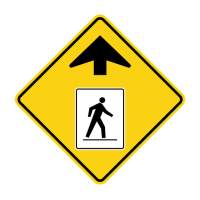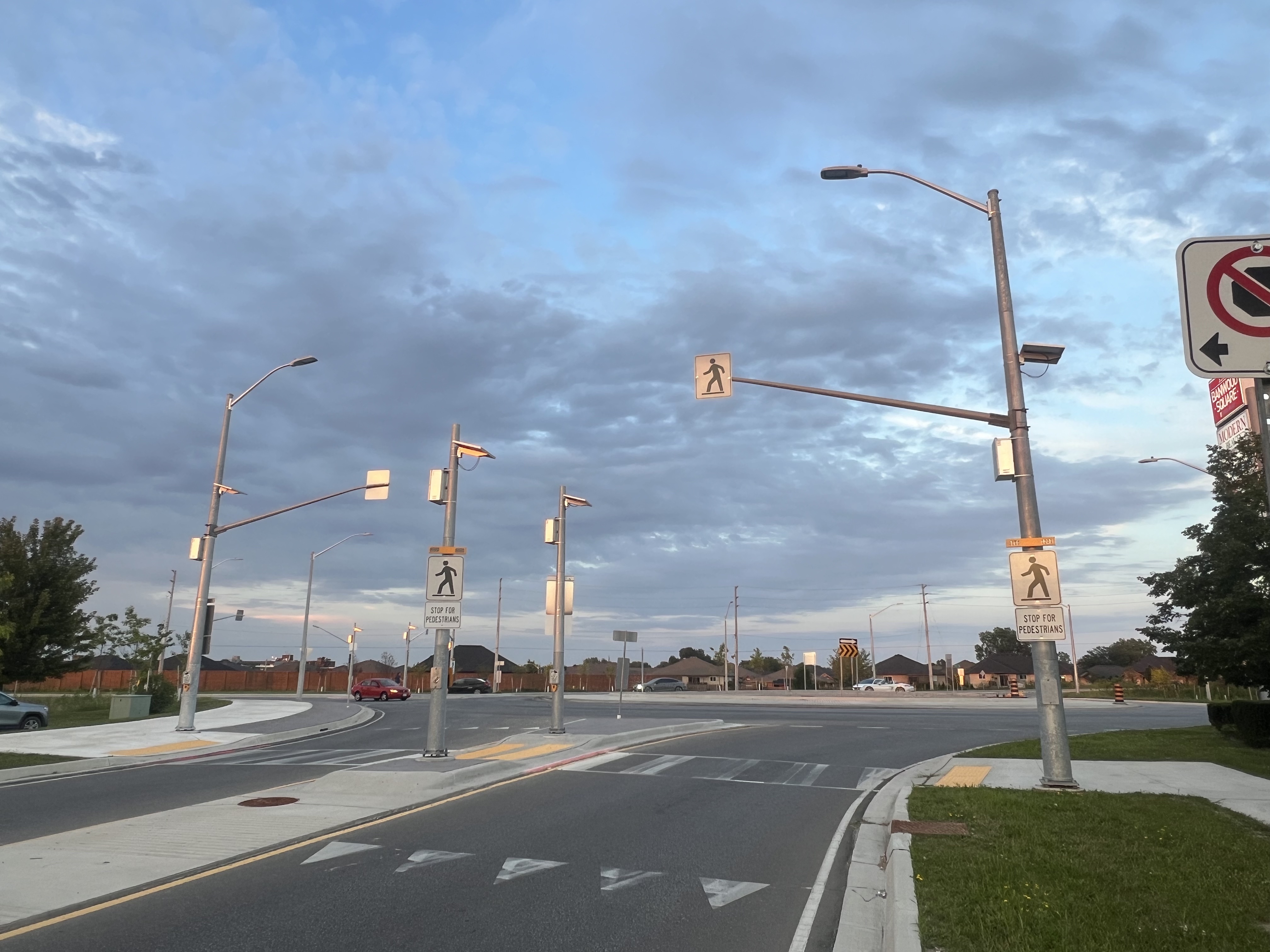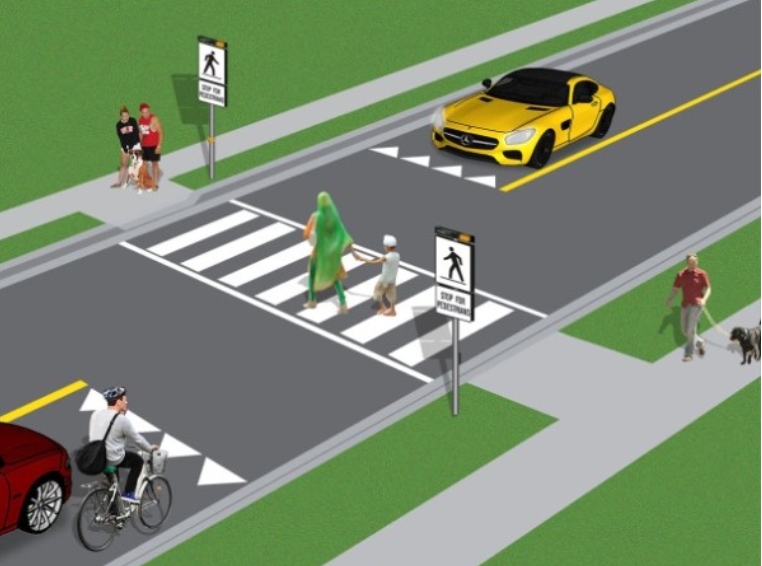Pedestrian Crossovers (PXOs)
Pedestrian crossovers (PXOs) provide pedestrians with crossing opportunities by requiring motorists and cyclists to yield to pedestrians within the crosswalk. Drivers are legally required to stop if pedestrians are waiting to cross, regardless of whether the pedestrian crossover location has a flashing beacon or not.
PXOs are intended for low-to-moderate-volume, low-speed roadways (60 kilometres per hour or less posted speed) and must not be used where the road volume exceeds 35,000 annual average daily traffic (AADT). PXOs should not be installed at sites where there are heavy volumes of turning traffic or where there are more than four lanes of two-way traffic or three lanes of one-way traffic. PXOs should not be within 200 metres of other signal-protected pedestrian crossings. Parking and other sight obstructions should be prohibited within at least 30 metres of the crossings. Regulation 615 of the Highway Traffic Act (HTA) covers most aspects of required PXO traffic control devices and their placement.
Stopping at a PXO helps protect lives. Failing to yield to a pedestrian on a PXO carries a fine of up to $1,000 and 4 demerit points.
New Pedestrian Crossovers:
- Little River Boulevard at Cora Greenwood Drive
- Pillette Road at Milloy Street
- Jefferson Boulevard at Coronation Avenue
- Wyandotte Street East at Marentette Avenue
- Sunset Avenue at University of Windsor Conference and Accommodation Centre
- Freedom Way at Park Street East
- Lauzon Parkway at Forest Glade Drive
- Matchett Road at Titcombe Road (Ojibway Nature Centre)
- Rhodes Drive at Electricity Drive
- Riverside Drive at Coventry Gardens
- Dandurand Avenue at Dandurand Court
Map of Pedestrian Crossovers and Traffic Calming within the city of Windsor (39 MB)
How to use a Pedestrian Crossover:
Pedestrian:
- Stand next to the "Stop for Pedestrians" sign and put your arm out to indicate to drivers that you want to cross.
- If the pedestrian crossover has flashing beacons, press the button to activate the amber flasher.
- Wait for traffic to stop.
- Make eye contact with drivers to ensure that they see you.
- Cross only when traffic has come to a complete stop or has enough time to stop before you begin to cross.
Driver:
- Look for the signs and slow down.
- Be prepared to stop for a pedestrian waiting to cross the road.
- Stop behind the yield line. This looks like shark teeth.
- Make eye contact with the pedestrian to make sure they see you and to let them know it's safe to cross.
- Wait until the pedestrian completely crosses the road before proceeding.
- Never pass a vehicle that has stopped to allow pedestrians to cross the road.
Cyclists:
- Cyclists approaching the pedestrian crossover must stop behind the yield line. This looks like shark teeth.
- Cyclists using the pedestrian crossover must dismount and walk the bike across the road.
Educational Video on How to Use a Pedestrian Crossover:
Types of Pedestrian Crossovers:
Pedestrian Crossover - Type B & C:
Some pedestrian crossovers include side-mounted "Stop for Pedestrians" signs, pavement markings, and flashing beacons with push buttons that can be activated by pedestrians. In some cases, overhead signs are also added. These are commonly found on single or multi-lane roadways with low to medium traffic volume. Drivers are legally required to stop at all pedestrian crossover locations, with or without flashing beacons, if pedestrians are waiting to cross.

Above location: Type B pedestrian crossover at Rhodes Drive and Electricity Drive Intersection in Windsor, Ontario.
Pedestrian Crossover - Type D:
Some pedestrian crossovers feature pavement markings on the ground, and "Stop for Pedestrians" signs on both sides of the road without flashing beacons. These are typically seen on low-traffic single-lane roads or at single-lane roundabouts. Drivers are legally required to stop at all pedestrian crossover locations, with or without flashing beacons, if pedestrians are waiting to cross.

Above location: Type D pedestrian crossover at Richmond Street and Chilver Road Intersection in Windsor, Ontario.
How to Recognize Pedestrian Crossovers:
Look for Signs and Pavement Markings:
Ladder crossing pavement markings, shown below, indicate where pedestrians are allowed to cross the road. They look like zebra stripes. The yield line, which looks like shark teeth, indicates where vehicles are required to stop when a pedestrian is waiting to cross the road. All crossovers have curb cuts and tactile plates to help make the crossing more accessible.

"Stop for Pedestrians" Signs:

"Stop for Pedestrians" signs are located at all pedestrian crossover locations.
"No Passing Here to Crossing" Signs:

"No Passing Here To Crossing" signs are located 30 metres from the pedestrian crossover. Drivers cannot pass any vehicle within 30 metres of a pedestrian crossover.
"Pedestrian Crossover Ahead" Signs:

"Pedestrian Crossover Ahead" signs are installed to warn drivers and are located 50 metres to 130 metres from the pedestrian crossing.
Pedestrian Crossovers at Roundabouts:
Pedestrian crossovers were installed at the roundabout intersection of Banwell Road and Mulberry Drive.
Tips for Crossing the Street at a Roundabout:
- Use the designated crossings and sidewalks or multi-use paths.
- Travel around the outside, crossing one direction of vehicle traffic at a time and pausing on the pedestrian islands in between.
- Always make sure drivers stop, or there is a gap in traffic, before you cross.
- If the crossing has a push button, press it to activate the flashing beacons.
- Make eye contact with any drivers approaching the crosswalk to ensure they've seen you.
- Cross only when traffic has come to a complete stop or has enough time to stop before you begin to cross.

Above location: Type B pedestrian crossover at Banwell Road and Mulberry Drive Roundabout in Windsor, Ontario.
Pedestrian Crossover Benefits:
Pedestrian crossovers have a number of benefits, including the following:
- Improved Safety: Pedestrian crossovers enhance safety by providing designated areas for pedestrians to cross roads. This helps reduce collisions involving pedestrians and drivers, as drivers are more likely to be aware of and yield to pedestrians in these marked areas.
- Accessibility: Pedestrian crossovers make streets more accessible for individuals with disabilities, including those using wheelchairs, walkers, or other mobility aids. They feature curb cuts and tactile indicators to assist blind or low-vision pedestrians in navigating safely.
- Encourages Walking and Active Transportation: By providing safe and convenient crossing points, pedestrian crossovers encourage walking and other forms of active transportation. This can contribute to improved personal health by promoting physical activity and reducing reliance on automobiles.
- Community Connectivity: Pedestrian crossovers help connect different parts of a community, facilitating pedestrian access to schools, parks, businesses, public transportation, and other amenities. This fosters a sense of community and promotes social interaction.
- Traffic Calming: Pedestrian crossovers can serve as a form of traffic calming by prompting drivers to slow down and be more cautious in areas with high pedestrian activity. This can help reduce vehicle speeds and create a safer environment for all road users.
- Environmental Benefits: Encouraging walking and active transportation through pedestrian crossovers can help reduce greenhouse gas emissions and air pollution associated with motor vehicle use. This aligns with sustainability goals and contributes to a healthier environment.
Visit Ontario Government Driving and Roads: Driving near pedestrian crossovers and school crossings for more information.
Transportation Services
1266 McDougall Street
Windsor, Ontario, Canada, N8X 3M7
Hours of Operation: Monday to Friday (excluding holidays) 8:30 a.m. to 4:30 p.m.
For general information or to request a PXO at a location, please call 311. For detailed inquiries, please contact 311@citywindsor.ca via email.

